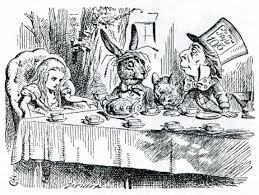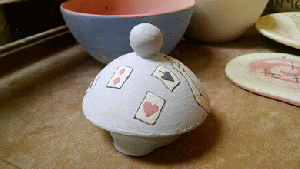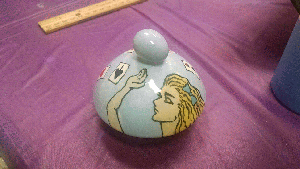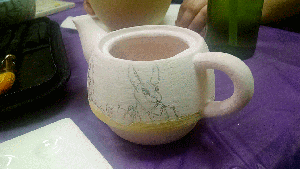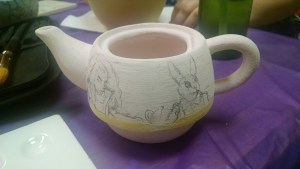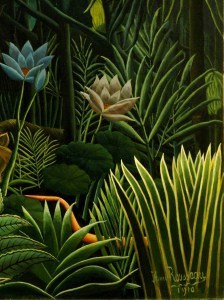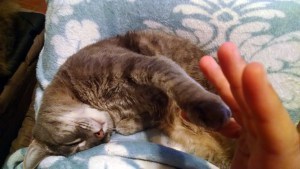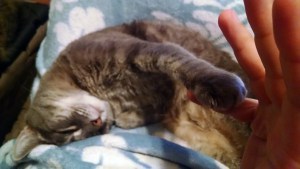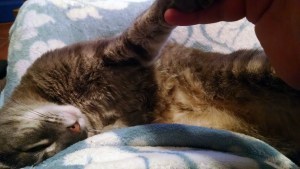Rachel Swirsky's Blog, page 26
March 14, 2016
New to the Net: “Monstrous Embrace”
Originally published at Rachel Swirsky. You can comment here or there.
Continuing my theme of reporting late on my news–for the first time, “Monstrous Embrace” is online in print, courtesy of Lightspeed Magazine.
The first line came to me in one of those strange, clear moments:
I am ugliness in body and bone, breath and heartbeat. I am muddy rocks and jagged scars snaking across salt-sown fields. I am insect larvae wriggling inside the great dead beasts into which they were born. Too, I am the hanks of dead flesh rotting. I am the ungrateful child’s sneer, the plague sore bursting, the swing of shadow beneath the gallows rope. Ugliness is my hands, my feet, my fingernails. Ugliness is my gaze, boring into you like a worm into rotting fruit.
Listen to me, my prince. Tomorrow, when dawn breaks and you stand in the chapel accepting your late father’s crown, your fate will be set. Do nothing and you will be dead by sundown. Your kingdom will be laid waste, its remnants preserved only in the bellies of carrion birds.
There is another option. Marry me.
The voice on this story was driving. It forced me rapidly through the story. Although I did a lot of revision later, I wrote the whole first draft in a few fluid hours. That’s rare enough for me to savor.
You can also find an audio version at PodCastle.
March 11, 2016
Favorite Fiction Recommendation: “This Strange Way of Dying” by Silvia Moreno-Garcia
Originally published at Rachel Swirsky. You can comment here or there.
I was occasionally, informally reading slush for Giganotosaurus at the time this story came into the inbox. I read Moreno-Garcia’s version of a maiden and Death, and recommended the delicate prose and imagery to Ann Leckie who eventually made the purchase.
It begins:
Georgina met Death when she was ten. The first time she saw him she was reading by her grandmother’s bedside. As Georgina tried to pronounce a difficult word, she heard her grandmother groan and looked up. There was a bearded man in a top hat standing by the bed. He wore an orange flower in his buttonhole, the kind Georgina put on the altars on the Day of the Dead.
The man smiled at Georgina with eyes made of coal.
Read here.
March 10, 2016
Alice’s Tea Party, pottery project in progress
Originally published at Rachel Swirsky. You can comment here or there.
When I was a kid, I took art lessons for a number of years in the garage of the professional artist who just happened to be living in our neighborhood. I’m not great at drawing, but I enjoy working with my hands immensely, and I’m usually happier if I’ve got a regular hobby going that involves making or drawing art.
For a while, that was jewelry-making, and I may post some of my jewelry and sketches online at some point. I got overexcited about making necklaces symbolizing fairy tales and myths which was neat, but expensive, and took a lot of creative energy. At the moment, I’m mostly doing art and comics on my iPad with my fancy new stylus.
I’m also painting pottery. Not making pottery. Painting it. You know, like at the pottery painting places. I go to the Color Me Mine near where Mike works. You buy pieces of unfired pottery and then paint them using on-site supplies.
My current project is a three-part teapot:
The top part is a lid. The middle part is a kettle, and the bottom part is a cup.
I decided to do it up with scenes from the original illustrations of Alice in Wonderland. (Alice was on my mind because of my recently published story about the hatter and hare having a love affair.) On the lid, I’m doing Alice being assailed by cards:
And on the middle, I’m doing the tea party.
On the bottom, I’m doing the Cheshire cat, but he’s not so much Tenniel’s as a blend of different interpretations of the Cheshire cat, painted purple. I don’t have any photographs of that part of the kettle yet anyway, so moving on.
I’ve finished the lid and had it fired. The firing process is interesting because of the way that it erases a lot of the shading, while at the same time making things look polished and vibrant. I often like the look of the unfired pottery better than the look of the fired pottery, but that might be because you can make the unfired version look however you want; the firing will still be a surprise. (A relatively predictable one, yes, but it makes some changes.)
The lid, unfired:
The lid, fired:
I did a sketch of the tea party, but I’m still coloring it in. (You can see where I am marking off and painting a yellow tablecloth.) For some reason, the gif we tried to take didn’t work. It left out some angles which makes it kind of trippy. I added in a couple stills:
I’ll post updates as the work continues. Alas, I am slow and perfectionistic about this, as I am about everything else.
March 9, 2016
FogCon: March 11-13
Originally published at Rachel Swirsky. You can comment here or there.
Mike and I will be at FogCon this year from March 11 to March 13. I’m not on any panels, but feel free to come bug me for a chat.
In March, I will also be attending AWP in Los Angelos, and ICFA in Orlando. In May, Mike and I will be at the Nebulas in Chicago. Those are our only convention plans this year. (Unless someone wants to invite me as a guest…?
March 8, 2016
A Silly Interview with Tina Gower, newly published debut novelist!
Originally published at Rachel Swirsky. You can comment here or there.
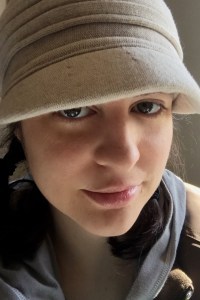 Many thanks to Tina Gower for agreeing to do a silly interview with me!
Many thanks to Tina Gower for agreeing to do a silly interview with me!
Tina’s bio has a typical writery buffet of eclectic experiences: “Tina Gower grew up in a small community in Northern California that proudly boasts of having more cows than people. She raised guide dogs for the blind, is dyslexic, and can shoot a gun or bow and miraculously never hit the target (which at some point becomes a statistical improbability).”
She also has a bunch of writing achievements, but this *is* a silly interview. (Though I admit it begins with me asking about her writing, and a picture of her book.
Later I bug her with questions about dogs and hats, though.
*
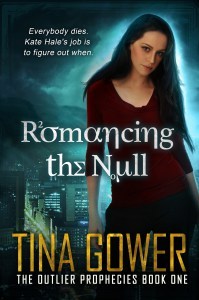 1) The heroine of your book specializes in statistics as an actuary for the accidental death department. Have you worked in jobs that require that kind of statistical analysis? If not, what appealed to you about writing such a character?
1) The heroine of your book specializes in statistics as an actuary for the accidental death department. Have you worked in jobs that require that kind of statistical analysis? If not, what appealed to you about writing such a character?
I’ve never worked as an actuary or any kind of risk assessment except for the anxiety of always thinking about the worst case scenario in my head. I have, however, worked with statistics as a school psychologist where I had to calculate student test or IQ scores on the bell curve or create measures. While in graduate school, we had to take a lot of psychometrics and statistics to complete the degree. Seriously, statistics is the most fun of all the math classes. I’m pretty sure
March 7, 2016
New Story: “Between Dragons and Their Wrath”
Originally published at Rachel Swirsky. You can comment here or there.
February is always one of the busiest months for me. This February was so busy that I didn’t remember to click “post” on the entry I’d written about my new story in Clarkesworld Magazine, “Between Dragons and Their Wrath.” I wrote it with my former student, An Owomoyela.
Fourteen-year-old Domei lives in a world jagged with the dangerous, magical scraps from someone else’s war:
In the forest, scales are most common. If they cut you, the cut will never stop bleeding.
If you step in a place where a dragon has defecated, food will stream through your body, and you will always be hungry. If you pass a place where a dragon breathed fire, your skin will forever blister and heal and then blister again. If you touch a dragon’s blood, you’ll go mad.
As for me, I was harvesting scales. With a scale, you can till the land faster than anyone using an iron hoe. You can butcher meat in a tenth the time it takes to use a knife. There are good things about dragon leavings, and for those good things, I usually get paid enough to eat.
Scales are common. Everyone knows about those. It was something else that got me.
This story began with a draft An wrote years ago. Last summer, they handed it to me, and I worked on the plot and characters. It was interesting starting with material that wasn’t mine, trying to understand the inside of the story enough to be able to continue and enhance the work that’s already there. I don’t think of An and myself as particularly similar writers, but I think we may approach structure the same way. It’s easier for me to put myself intuitively into their stories than it has been for other people I’ve tried this exercise with. (I do hope that some of those attempts will lead to other published stories also.)
Another excerpt (almost totally written by An):
During the war, the Andé slaughtered a big dragon the size of a mountain. They dropped its liver and gall on Hizhang. Bile poisoned the earth, poisoned the air, poisoned the people and the children of the people, and is still poisoning them now. People born in Hizhang have probably never seen a dragon, but they don’t need to.
Every dusk, the cows start lowing from Hizhang. But there are no longer cows in Hizhang.
You see, we were lucky.
The story is also available in audio, narrated by Kate Baker.
March 4, 2016
Favorite Fiction Recommendation: “Her Husband’s Hands” by Adam Troy-Castro
Originally published at Rachel Swirsky. You can comment here or there.
“Her Husband’s Hands” by Adam Troy-Castro, originally published in 2011, was honored with a Nebula nomination. The story was one of my picks as well as that of the membership at large. It’s a disturbing story, no doubt about it. At the time, I wrote (rephrased somewhat to make the writing sharper):
A war widow receives bad news from the front: her husband is dead. However, they’ve managed to save his hands, and only his hands… It’s dark, intensely written, and intimately and compassionately characterized
From the story:
Her husband’s hands came home on a Friday. Rebecca had received word of the attack, which had claimed the lives of seven other soldiers in his unit and reduced three others to similar, minimal fractions of themselves: One man missing above the waist, another missing below, a third neatly halved, like a bisected man on display in an anatomy lab.
The Veteran’s Administration had told her it could have been worse. The notification officer had reminded her of Tatum, the neighbor’s daughter so completely expunged by her own moment under fire that only a strip of skin and muscle remained: A section of her thigh, about the size and shape of a cigarette pack, returned to her parents in a box and now living in their upstairs room, where it made a living proofreading articles on the internet. That’s no life, the notification officer said. But Bob, he pointed out, was a pair of perfect hands, amputated from the body at the wrists but still capable of accomplishing many great things. And there was always the cloning lottery. The chances were a couple of million to one, but it was something to hope for, and stranger things had happened.
Around 2011, there was a strong trend of stories about processing PTSD. It’s still a theme now, but it was even more dominant then. At 6,000 words, it’s a lot of emotional impact in a small space.
March 3, 2016
Kitty Pattycake
Originally published at Rachel Swirsky. You can comment here or there.
Mike and Zephyr play patty cake.
March 2, 2016
Quick Notes: Poetry Planet podcast, & Tiptree Anthology 99 Cents
Originally published at Rachel Swirsky. You can comment here or there.
A few quick notes for this week.
Poetry Planet podcast
Diane Severson puts together the poetry planet podcast that aired recently in this episode of starship sofa. She includes my poem, “Terrible Lizards,” which is about — as you might expect — dinosaurs. She asked me to include an anecdote about it:
1) I love dinosaurs. I never went through a dinosaur phase as a kid, but my husband never got over his, so when I met him in college, I got to have a late dinosaur phase, which we still enjoy together.
2) I was driving cross-country through the midwest (well, my husband was driving and I was passengering) and staring out of the windows at all the flat land, and trying to visualize cool things walking through it, which my husband can do and which I mostly can’t. Then I saw one of those huge irrigation devices and realized it was about dinosaur-sized. I never got the visualization trick down, but I can do the imagining with words thing.
Listen here.
Tiptree Anthology available at 99 cents:
Last year, I was honored to participate in the anthology project Letters to Tiptree.
For nearly a decade, between 1968 and 1976, a middle-aged woman in Virginia (her own words) had much of the science fiction community in thrall. Her short stories were awarded, lauded and extremely well-reviewed. They were also regarded as “ineluctably masculine”, because Alice Sheldon was writing as James Tiptree Jr.
In celebration of the 100th Anniversary of Alice Sheldon’s birth, and in recognition of the enormous influence of both Tiptree and Sheldon on the field, Twelfth Planet Press has published a selection of thoughtful letters written by science fiction and fantasy’s writers, editors, critics and fans to celebrate her, to recognise her work, and maybe in some cases to finish conversations set aside nearly thirty years ago.
I gave my answer in the form of a poem.
If you’re a Tiptree fan, now is the time to buy the book–until March 31, it’s available at 99 cents.
March 1, 2016
New Story: “Love Is Never Still”
Originally published at Rachel Swirsky. You can comment here or there.
“Love Is Never Still” just came out in Issue 9 of Uncanny Magazine, a story about Galatea and Aphrodite, and their broken, bittersweet love affairs. The story begins with the sculptor’s perspective:
“I’ve loved other sculptures. Though I’m not yet old, I have worked diligently at my art, and so have loved hundreds. I have loved leaping horses and dour-faced spearmen and exotic animals pieced together from sailors’ descriptions.
Galatea is my culmination. From the beginning, winnowing the ivory to her form has felt more like discovery than invention. Our bodies move together in conversation; mine contorts as I twist and crouch to discover precise angles, and she emerges from my labor.”
This took me about four months of intense concentration to write because it features about fifteen perspectives (the number went up and down while I was drafting) and the writing is very precise. Sometimes it felt like I was writing a really long poem. I actually wrote part of the story in verse (iambic pentameter), but my friend Barry Deutsch rightly convinced me that it slowed the story way down.
I’ll try to tempt you to read with another passage, this time from Galatea’s perspective:
Birth is pain, and I have been twice born. First I was an egg of ivory until he struck away the pieces that were not me and cracked me open. Later, the goddess touched me with her fiery fingertips and melted away the good, solid quiet of my soul. She made me into hot, fragile skin, always beating with blood.
What misery it is to crack at the seams, to be forever bending and reshaping. Once, my body held its place in the world; once, it stood in perfect, unchanging balance. Now I am walking, stumbling, falling, sitting, smiling, resting, startling, kneeling, offering, dressing, approaching, avoiding.
My sculptor is nearby, but turns his face away. I chew a cube of cheese and swallow. Even my insides move.
Read here.



